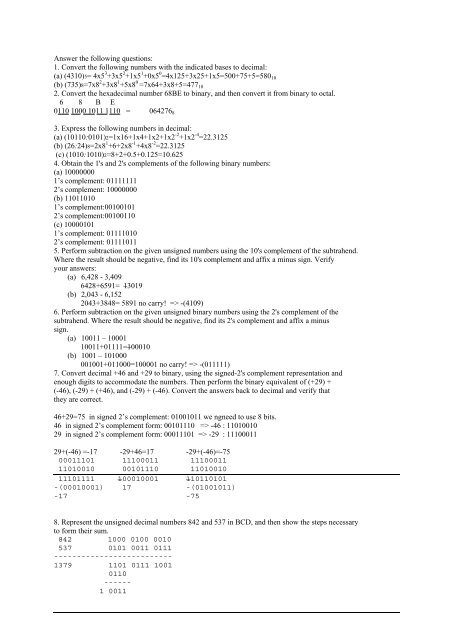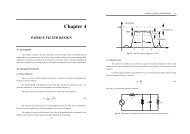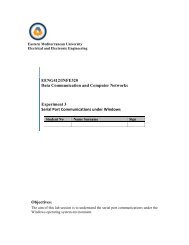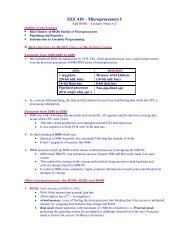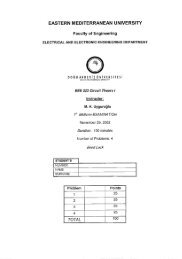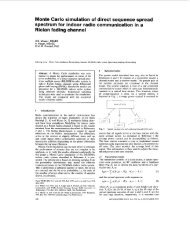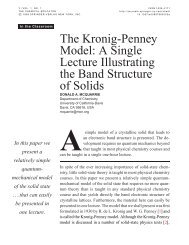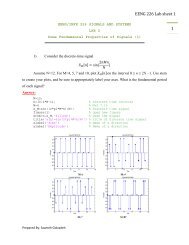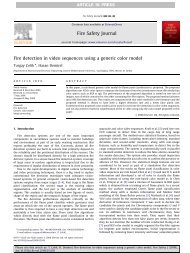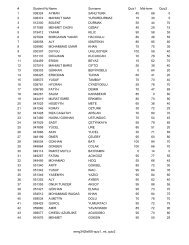1. Convert the following numbers with the indicated bases ... - faraday
1. Convert the following numbers with the indicated bases ... - faraday
1. Convert the following numbers with the indicated bases ... - faraday
You also want an ePaper? Increase the reach of your titles
YUMPU automatically turns print PDFs into web optimized ePapers that Google loves.
Answer <strong>the</strong> <strong>following</strong> questions:<strong>1.</strong> <strong>Convert</strong> <strong>the</strong> <strong>following</strong> <strong>numbers</strong> <strong>with</strong> <strong>the</strong> <strong>indicated</strong> <strong>bases</strong> to decimal:(a) (4310)5= 4x5 3 +3x5 2 +1x5 1 +0x5 0 =4x125+3x25+1x5=500+75+5=580 10(b) (735)8=7x8 2 +3x8 1 +5x8 0 =7x64+3x8+5=477 102. <strong>Convert</strong> <strong>the</strong> hexadecimal number 68BE to binary, and <strong>the</strong>n convert it from binary to octal.6 8 B E0110 1000 1011 1110 = 064276 83. Express <strong>the</strong> <strong>following</strong> <strong>numbers</strong> in decimal:(a) (10110:0101)2=1x16+1x4+1x2+1x2 -2 +1x2 -4 =22.3125(b) (26:24)8=2x8 1 +6+2x8 -1 +4x8 -2 =22.3125(c) (1010:1010)2=8+2+0.5+0.125=10.6254. Obtain <strong>the</strong> 1's and 2's complements of <strong>the</strong> <strong>following</strong> binary <strong>numbers</strong>:(a) 100000001’s complement: 011111112’s complement: 10000000(b) 110110101’s complement:001001012’s complement:00100110(c) 100001011’s complement: 011110102’s complement: 011110115. Perform subtraction on <strong>the</strong> given unsigned <strong>numbers</strong> using <strong>the</strong> 10's complement of <strong>the</strong> subtrahend.Where <strong>the</strong> result should be negative, find its 10's complement and affix a minus sign. Verifyyour answers:(a) 6,428 - 3,4096428+6591= 13019(b) 2,043 - 6,1522043+3848= 5891 no carry! => -(4109)6. Perform subtraction on <strong>the</strong> given unsigned binary <strong>numbers</strong> using <strong>the</strong> 2's complement of <strong>the</strong>subtrahend. Where <strong>the</strong> result should be negative, find its 2's complement and affix a minussign.(a) 10011 – 1000110011+01111=100010(b) 1001 – 101000001001+011000=100001 no carry! => -(011111)7. <strong>Convert</strong> decimal +46 and +29 to binary, using <strong>the</strong> signed-2's complement representation andenough digits to accommodate <strong>the</strong> <strong>numbers</strong>. Then perform <strong>the</strong> binary equivalent of (+29) +(-46), (-29) + (+46), and (-29) + (-46). <strong>Convert</strong> <strong>the</strong> answers back to decimal and verify that<strong>the</strong>y are correct.46+29=75 in signed 2’s complement: 01001011 we ngneed to use 8 bits.46 in signed 2’s complement form: 00101110 => -46 : 1101001029 in signed 2’s complement form: 00011101 => -29 : 1110001129+(-46) =-17 -29+46=17 -29+(-46)=-7500011101 11100011 1110001111010010 00101110 1101001011101111 100010001 110110101-(00010001) 17 -(01001011)-17 -758. Represent <strong>the</strong> unsigned decimal <strong>numbers</strong> 842 and 537 in BCD, and <strong>the</strong>n show <strong>the</strong> steps necessaryto form <strong>the</strong>ir sum.842 1000 0100 0010537 0101 0011 0111--------------------------1379 1101 0111 10010110------1 0011
9. Decode <strong>the</strong> <strong>following</strong> ASCII code:1000010 1101001 1101100 1101100 1000111 1100001 1110100 1100101 1110011B i l l G a t e s


